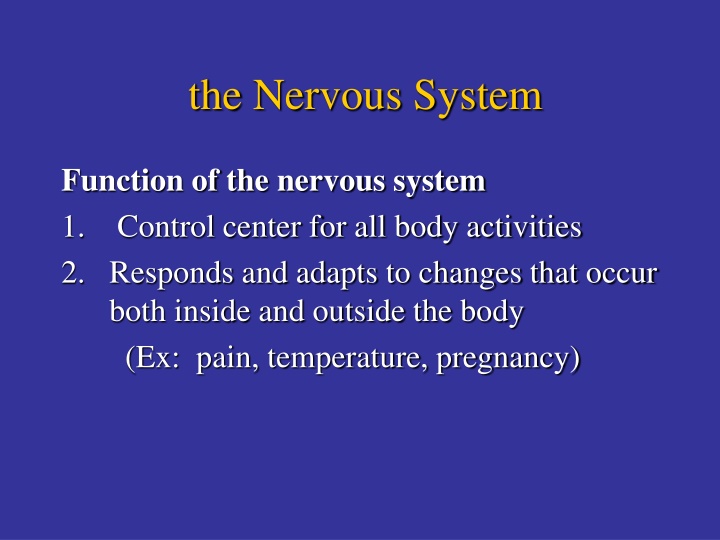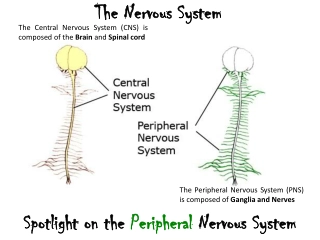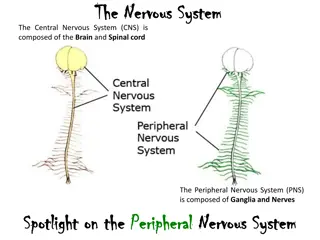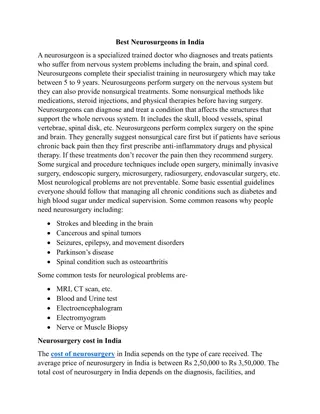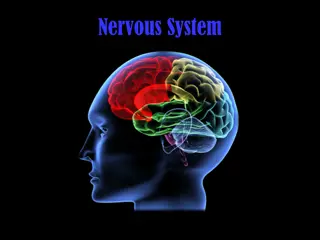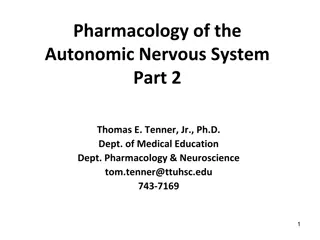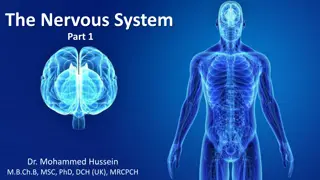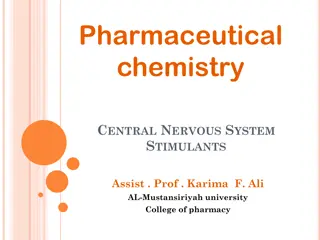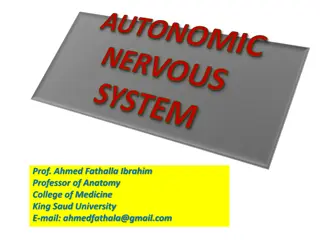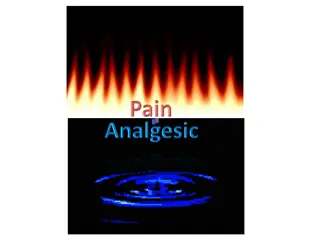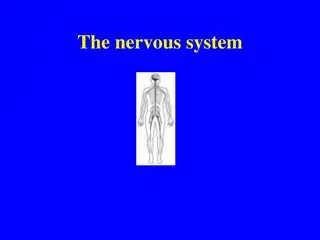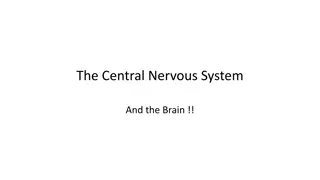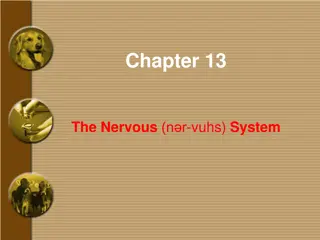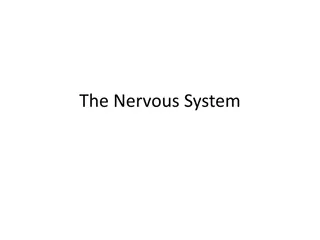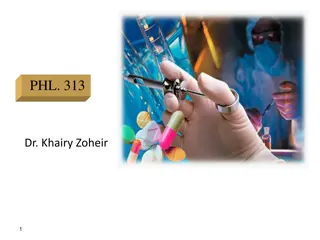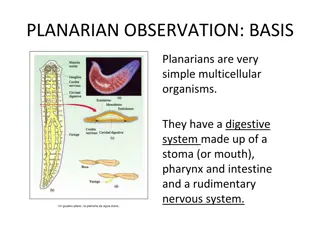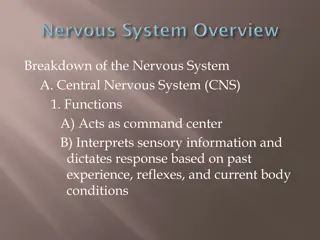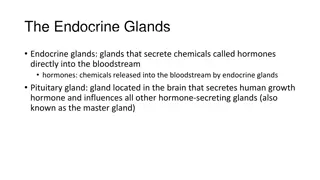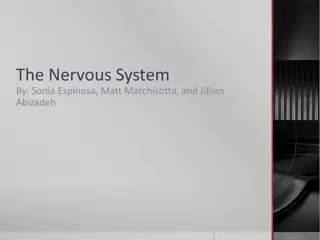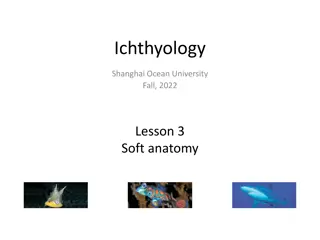the Nervous System
The nervous system serves as the control center for all body activities, responding and adapting to internal and external changes. It comprises the Central Nervous System, which includes the brain with its various regions, such as the cerebrum, diencephalon, brainstem, and cerebellum. The cerebrum, the largest part of the brain, is responsible for thought, language, senses, memory, and voluntary movement. The diencephalon contains structures like the thalamus and hypothalamus, crucial for relay and homeostatic functions. Explore more about the intricate workings of the nervous system through its components and functions.
Download Presentation

Please find below an Image/Link to download the presentation.
The content on the website is provided AS IS for your information and personal use only. It may not be sold, licensed, or shared on other websites without obtaining consent from the author.If you encounter any issues during the download, it is possible that the publisher has removed the file from their server.
You are allowed to download the files provided on this website for personal or commercial use, subject to the condition that they are used lawfully. All files are the property of their respective owners.
The content on the website is provided AS IS for your information and personal use only. It may not be sold, licensed, or shared on other websites without obtaining consent from the author.
E N D
Presentation Transcript
the Nervous System Function of the nervous system 1. Control center for all body activities 2. Responds and adapts to changes that occur both inside and outside the body (Ex: pain, temperature, pregnancy)
Two Major Divisions of the Nervous System
Central Nervous System Brain : a mass of 100 billion neurons located inside the skull, The brain has four different regions: the cerebrum, diencephalon, brainstem, and cerebellum. The cerebrum and diencephalon together constitute the forebrain. The brainstem consists of the midbrain, pons, and medulla oblongata. The brain also contains interconnected cavities, the cerebral ventricles, which are filled with fluid.
Cerebrum : largest part of human brain - Responsible for: - Thought - Language - Senses - Memory - Voluntary movement
The larger component of the forebrain, the cerebrum, consists of the right and left cerebral hemispheres as well as some associated structures on the underside of the brain. The central core of the forebrain is formed by the diencephalon. The cerebral hemispheres consist of the cerebral cortex an outer shell of gray matter composed of cell bodies that give the area a gray appearance and an inner layer of white matter, composed primarily of myelinated fibers.
The diencephalon is the second component of the forebrain. It contains the thalamus, hypothalamus, and epithalamus. The thalamus is a collection of several large nuclei that serve as synaptic relay stations and important integrating centers for most inputs to the cortex, and it plays a key role in general arousal. the hypothalamus is the single most important control area for homeostatic regulation of the internal environment. Behaviors having to do with preservation of the individual (for example, eating and drinking) and preservation of the species (reproduction) are among the many functions of the hypothalamus.
The hypothalamus lies directly above and is connected by a stalk to the pituitary gland, an important endocrine structure that the hypothalamus regulates. The epithalamus is a small mass of tissue that includes the pineal gland, which has a role in regulating circadian rhythms through release of the hormone melatonin . The cerebellum (which is Latin for little brain ) is a major structure of the hindbrain that is located near the brainstem. This part of the brain is responsible for coordinating voluntary movements. responsible for a number of functions including motor skills such as balance, coordination, and posture. It is also
Anatomy of the Brain Brain Stem : connects brain to spinal cord -Responsible for: - Breathing - Swallowing - Heartbeat - Blood pressure
Brain stem contains all the fibers passing between the spinal cord, forebrain, and cerebellum , - Contains the reticular formation and its various integrating centers, cardiovascular and respiratory activity including those for
Central Nervous System Spinal Cord : Column of nerves from brain to tailbone protected by vertebrae of spine - Responsible for: - Conducting impulses between the brain and the rest of the body *Impulses may travel as fast at 268 miles/hr
The central butterfly-shaped area (in cross section) of gray matter is composed of interneurons, the cell bodies and dendrites of efferent neurons, the entering axons of afferent neurons, and glial cell. The gray matter is surrounded by white matter, which consists of groups of myelinated axons. These groups of fiber tracts run longitudinally through the cord, some descending to relay information from the brain to the spinal cord, others ascending to transmit information to the brain.
Peripheral nervous system include all the neural tissue outside the CNS. The PNS delivers sensory information to the CNS & carries motor commands to the peripheral tissue & systems. Afferent division of PNS brings sensory information to CNS from receptors in peripheral tissue & organs. Efferent division of PNS carries motor commands from the CNS to muscles & glands (effectors).
The Efferent division has Somatic & autonomic components: * The somatic nervous system (SNS) controls skeletal muscles contractions (the contractions may be voluntary or involuntary. * The autonomic nervous system (ANS) or visceral motor system, provides automatic involuntary regulation of smooth muscle, cardiac muscle, glandular activity or secretion, include: -sympathetic division. -parasympathetic division.
The PNS has 43 pairs of nerves: 12 pairs of cranial nerves and 31 pairs of spinal nerves that connect with the spinal cord. The 31 pairs of spinal nerves are designated by the vertebral levels from which they exit. Neurons in the spinal nerves at each level generally communicate with nearby structures, controlling muscles and glands as well as receiving sensory input.
These peripheral nerves can contain nerve fibers that are the axons of efferent neurons, afferent neurons, or both. Therefore, fibers in a nerve may be classified as belonging to the efferent or the afferent division of the PNS. All the spinal nerves contain both afferent and efferent fibers, whereas some of the cranial nerves contain only afferent fibers (the optic nerves from the eyes, for example) or only efferent fibers (the hypoglossal nerve to muscles of the tongue, for example).
The autonomic nervous system: Function: The autonomic nervous system controls blood pressure, heart and breathing rates, body temperature, digestion, metabolism (thus affecting body weight), the balance of water and electrolytes (such as sodium and calcium), the production of body fluids (saliva, sweat, and tears), urination, defecation, sexual response, and other processes. Many organs are controlled primarily by either the sympathetic or the parasympathetic division. Sometimes the two divisions have opposite effects on the same organ. For example, the sympathetic division increases blood pressure, and the parasympathetic division decreases it. Overall, the two divisions work together to ensure that the body responds appropriately to different situations.
The sympathetic division prepares the body for stressful or emergency situations fight or flight. Thus, it increases heart rate and the force of heart contractions and widens (dilates) the airways to make breathing easier. It causes the body to release stored energy. Muscular strength is increased. This division also causes palms to sweat, and hair to stand on end. It slows body processes that are less important in emergencies, such as digestion and urination. The parasympathetic division controls body process during ordinary situations. Generally, it conserves and restores. It slows the heart rate and decreases blood pressure. It stimulates the digestive tract to process food and eliminate wastes.
Two acetylcholine and norepinephrine, are used to communicate within the autonomic nervous system. Nerve fibers that secrete acetylcholine are called cholinergic fibers. Fibers that secrete norepinephrine are called adrenergic fibers. Generally, acetylcholine has parasympathetic (inhibiting) effects and norepinephrine has sympathetic (stimulating) effects. However, acetylcholine has some sympathetic effects. For example, it sometimes stimulates sweating or makes the hair stand on end. chemical messengers (neurotransmitters),
The ANS pathway from the CNS to the effector always involves 2 neurons synapsing in an autonomic ganglion Preganglionic (neuron 1) cell body is in the CNS, axon extends to the ganglion outside the CNS Postganglionic (neuron 2) cell body is in the ganglion, axon extends to the visceral effector
Preganglionic (neuron #1) Always myelinated Neurotransmitter is always ACh Postganglionic (neuron #2) Always non myelinated Neurotransmitter is Ach or norepinephrine
